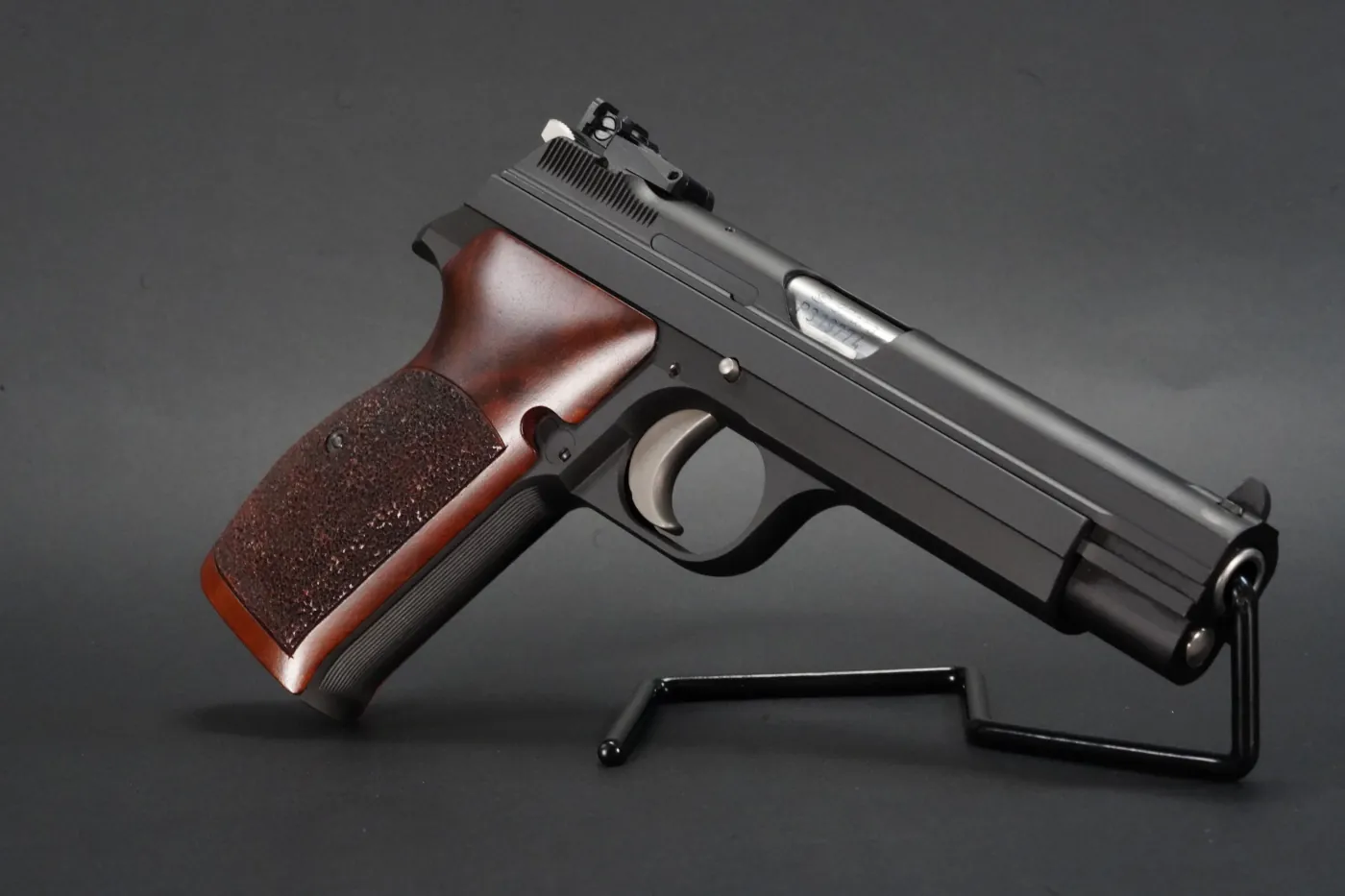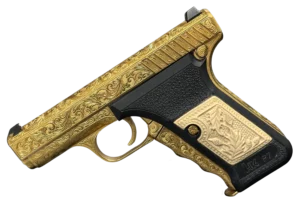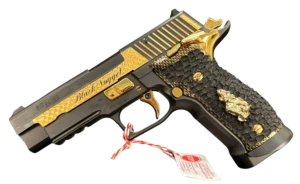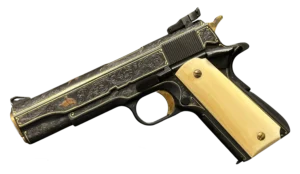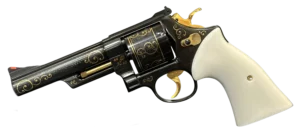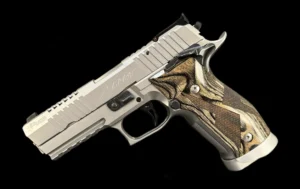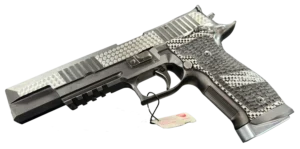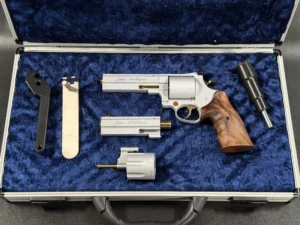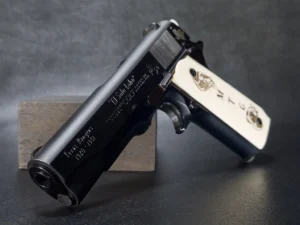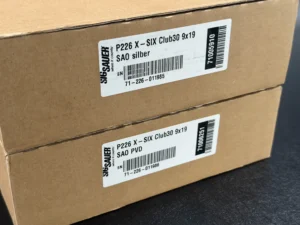Key Takeaways:
- The SIG P210 isn’t just a pistol—it’s an experience: From its origins as a Swiss military sidearm to its near-mythic status among collectors and marksmen, the P210 represents a level of craftsmanship that’s almost extinct. Everything about it—the inverted slide rails, the match-grade trigger, the hand-fitted parts—feels intentional, personal, and quietly brilliant.
- It earned its reputation the hard way: by outperforming everything else: No marketing gimmicks, no plastic wizardry—just tight tolerances, world-class accuracy, and a trigger that breaks like a secret. Whether you’re a seasoned shooter or a first-timer holding one at the range, the P210 doesn’t shout. It shows you what a pistol can be when it’s built without compromise.
- Collectible? Absolutely. Shootable? Even more so: Sure, there are pristine, unfired P210s sitting in safes like Fabergé eggs—but the true magic happens when you take one to the range. This pistol wasn’t designed to be babied. It was made to shoot tight groups, make you smile, and remind you that some things really were built better back then.
There are pistols… and then there’s the P210.
You’ve probably heard that line before—maybe in a gun shop or a magazine article with too much reverence. But in this case, it’s not hype. It’s just the truth. The SIG Sauer P210 is one of those rare firearms that feels like it doesn’t belong in a gun safe—it belongs in a museum, or maybe under glass in a Swiss bank vault. And yet, it begs to be shot.
Part mechanical marvel, part national treasure, the P210 is the gun that makes you slow down and appreciate the details. It’s not the loudest, flashiest, or most tactical thing in the room. But if you care about engineering, history, or what it means to build something right, the P210 will get under your skin—and stay there.
Let’s take a step back. Because before the match triggers, the $4,000 collector sales, and the quietly devoted fanbase, this pistol had a job to do. And it did that job so well, it ended up changing the game for everyone else.
A Swiss Watch with a Trigger – The Origins of the P210
Picture post-WWII Europe. Switzerland, officially neutral, is busy rearming itself with modern small arms, and not just anything will do. The Swiss Army wanted a service pistol that reflected the nation’s obsession with precision. No shortcuts. No compromises. Just pure performance.
So in 1949, SIG (Schweizerische Industrie Gesellschaft) rolled out the P49, later known as the P210. And it didn’t take long for people to realize this wasn’t just another semi-auto service pistol—it was something special.
The P210 wasn’t designed from thin air. Its DNA pulls from earlier Browning designs—especially the French M1935A—and combines them with that borderline neurotic level of mechanical refinement the Swiss are famous for. The result? A locked-breech, single-action pistol chambered in 9mm that felt like a custom job… even when it came off the assembly line.
And when we say “custom,” we don’t mean gimmicky slide cuts or Cerakote finishes. We mean hand-fitted internals, individually numbered parts, and tolerances so tight they make other service pistols look sloppy by comparison. It was a military sidearm that handled like a competition gun.
For decades, the Swiss Army carried it. So did elite police units. It became the gold standard for service pistol accuracy—no exaggeration. The P210 wasn’t just built to last. It was built to outperform.
But you know what’s funny? Despite being designed for military use, this gun speaks the loudest at the range.
A Fit Like No Other – Precision Manufacturing That Changed the Game
If you’ve ever stripped down a P210 and handled the slide and frame, you probably noticed something odd: it’s smooth, like weirdly smooth. That’s because the slide rides inside the frame rails, not over them like on a 1911 or Glock. It’s a small detail with big implications. This inverted rail design lowers the bore axis and tightens tolerances, making the pistol inherently more stable and accurate.
You know how some guns feel like they were built fast, in bulk, just good enough to get the job done? The P210 is the opposite of that. Every part feels like it was agonized over, blueprinted, and fussed into place by someone who probably skipped lunch just to get the trigger sear perfect.
And that’s not just poetic fluff—this gun is fitted so tightly that early models often had matching serial numbers not just on the frame and slide but also on tiny internal parts. That level of hand-fitting is usually reserved for bespoke 1911s or top-tier match pistols. The P210 had it right off the production line. Military-issued, mind you.
This was precision you could feel. The trigger broke like snapping glass. The barrel locked up the same way every time—no slop, no guesswork. The result? A pistol that could shoot inch-wide groups at 25 meters all day long, straight out of the holster.
To put it bluntly, most other service pistols didn’t even come close at the time. Some tried to be rugged. Some tried to be cheap. The P210 didn’t try to be anything—it just was better.
It’s like comparing a bespoke suit from Savile Row to something you grabbed last-minute at the department store. Both will technically do the job. But one of them makes you feel like James Bond. The P210? That’s the bespoke suit, with hand-stitched everything and a tailor who knew your wristwatch brand before you walked through the door.
The Military Standard, the Civilian Dream
The P210 was born in uniform. It was a matter of national pride and performance for the Swiss military. The official designation, Pistole 49, stood as the standard sidearm from 1949 until 1975, when it was eventually replaced by the more modern (and more affordable) SIG P220. But make no mistake: it didn’t get replaced because it was outdated. It got replaced because it was too good.
Let that sink in.
The P210 was so expensive to manufacture—so painstakingly crafted—that it became a logistical headache for military budgets. It was like handing out Rolexes to infantry. Sure, they’ll tell the time, but they might also bankrupt your supply chain.
And yet, by the time it was phased out, it had already carved its name into shooting folklore. Word had gotten around. Civilian shooters started hunting them down, especially in Europe, where a surplus Swiss service pistol with that kind of mechanical pedigree was considered gold. The moment surplus P210s hit the civilian market, they were snatched up by competition shooters and collectors alike.
For those in the know, it was the ultimate confluence: a military-grade sidearm with the heart of a match pistol.
SIG didn’t miss a beat. They rolled out civilian models—the P210-2, P210-4, and eventually the highly desirable P210-6, which came with adjustable sights and target-style grips. These weren’t watered-down versions. They were full-blown performance pistols, purpose-built for accuracy and serious shooting.
Target competitions? The P210 was everywhere. It won medals. It won hearts. And in the process, it earned the kind of fanbase most gunmakers can only dream of. Even when newer, polymer-framed pistols started dominating the tactical scene, the P210 kept its footing among purists. Because no matter how trendy things got, good machining and a perfect trigger never went out of style.
You know how some cars feel like they were built just to check a box, while others feel like the engineers cared? The P210 is the second kind, down to every spring, pin, and polish.
Handling a Legend – Shooting the P210
So, what’s it like to actually shoot a SIG P210?
Let’s not beat around the bush—it’s sublime. Not in the overblown, “this gun changed my life” kind of way, but in that quiet, deeply satisfying way where everything just clicks. You understand why people get poetic about this pistol the first time you squeeze the trigger.
The balance is the first thing that hits you. Even with the all-steel frame, it’s not front-heavy or clunky. It sits in the hand like it was designed for your palm—because, well, it kind of was. The grip angle is natural, the controls are clean and intuitive, and the whole gun feels like it’s working with you, not against you.
Then there’s the trigger. Oh man, the trigger.
It’s crisp. And not just “nice for a service pistol” crisp—it’s “match-grade, glass-rod-breaking, did-that-just-happen” crisp. It’s the kind of trigger you’d expect on a custom race gun. There’s no grit, no stacking, no mystery. Just steady pressure… and then bang. Every time.
Recoil? Mellow. Manageable. Almost… refined. The low bore axis (thanks again to that inside-the-frame slide design) keeps muzzle flip minimal, letting you get back on target fast. Even with hot 9mm loads, the P210 handles it like a champ—no drama, no slap, just that confident push you can easily control.
And accuracy? It’s hard to overstate. Even if you’re a weekend shooter, the P210 makes you feel like a bullseye god. Shots land where you want them—sometimes even when your fundamentals aren’t perfect. It’s like the gun forgives you a little. Helps you out. Says, “Don’t worry, I’ve got this.”
Shooting a P210 feels like driving an old Porsche with a manual gearbox—every movement is deliberate, mechanical, tactile.
- It demands your attention, but rewards your focus tenfold.
- It doesn’t shout.
- It doesn’t flash.
- It just does its job beautifully.
Compared to a modern striker-fired pistol? It’s night and day. Those plastic-fantastic guns are workhorses, sure. But the P210? That’s a precision instrument. A scalpel, not a hammer.
Variants, Imports, and Modern Rebirths
Now, here’s where things get fun—and, if you’re a collector, just a little obsessive. The P210 might seem like a single model, but in reality, it’s a family. And like any family, it’s got its share of personalities, upgrades, and drama.
The Swiss Originals
Let’s start with the early crew: the P210-1 through P210-4 were military primarily and police-oriented. The -1 and -2 models were built for the Swiss Army—robust, no-frills, precision-made tools. The P210-4 stands out because it was produced for the West German Border Police (yes, they picked the Swiss pistol over domestic options), and those are pretty rare now—especially with proper Bundesgrenzschutz markings intact.
Then came the P210-5 and P210-6—the absolute sweethearts of civilian target shooters. The -5 featured a longer barrel and adjustable sights, perfect for precision competitions. The P210-6? A P210, but tuned for sport shooting with tighter tolerances and upgraded sights. You’ll find these tucked away in velvet-lined cases at high-end gun shows, often with owners who aren’t really looking to sell.
Import Fever
For years, the U.S. market had to sit back and watch the Europeans enjoy all the fun. But slowly, P210s began making their way across the Atlantic. Importers like Hammerli and SIG Sauer USA brought in small batches—some surplus, some new—feeding a niche but hungry crowd of American shooters and collectors.
And with that scarcity came… well, let’s just call it “P210 fever.” Prices soared. Condition mattered more than ever. Matching serial numbers? Big deal. Factory boxes, manuals, or test targets? Jackpot.
Shooters wanted them. Collectors hoarded them. And the myth of the P210 kept growing.
SIG Sauer’s American Revival
Eventually, SIG Sauer took the hint and brought the legend home. In 2017, SIG Sauer USA released the P210A, built in New Hampshire, as a modern take on the classic. It wasn’t a replica, but it captured the soul of the original with some smart upgrades. Think: updated ergonomics, improved safety features, and a CNC-machined stainless frame.
Two standout models emerged:
- P210A Target: With a 5-inch barrel, adjustable sights, and wood grips, this was clearly aimed at range enthusiasts and traditionalists. It wasn’t just an homage—it was a shooter’s pistol, through and through.
- P210A Carry: Released later with a shorter barrel, slimmed-down controls, and more practical carry options. A bit of a curveball, but surprisingly popular among folks who wanted Old World accuracy in a modern carry package.
Now, some purists will argue these American-made P210s aren’t quite the same as the Swiss originals—and they’re not wrong. There are differences in feel, finish, and certain small parts. But for most shooters? The P210A series brings that same level of refinement and elegance, without the four-figure collector markup. And let’s be honest: most of us aren’t babying our guns in display cases. We want to shoot them. The P210A lets you do that—and then some.
Why Collectors Go Nuts for It
You don’t have to be a hardcore collector to get the itch. One look at a P210 in mint condition—with that deep blued finish, perfectly checkered grips, and numbers that match inside and out—and suddenly you’re browsing forums at 2 a.m. and whispering things like “pre-import P210-6 with original test target” like it’s a secret code.
So what’s the big deal? Why do collectors—and we’re talking serious, spreadsheet-making, safe-queen-loving types—get so worked up about this pistol?
Precision, Provenance, and Pride
First, it’s the craftsmanship. Even in today’s world of CNC everything, the Swiss P210 still feels different. The hand-fitting, the roll marks, the mechanical feel—it’s all just a step above. There’s no plastic. No shortcuts. And that holds serious appeal for folks who admire old-school manufacturing.
Then there’s the history. Some P210s served with the Swiss Army, others with elite police units. A few made it to the Olympics. And if you’re lucky enough to find one with documented military or competition use, well—that’s collector catnip right there.
But the real kicker? Rarity with a twist. Unlike limited-run boutique pistols that exist purely to be collectible, the P210 earned its following through performance. That means the best examples—early models in pristine condition, with original packaging, or military provenance—are few and far between. And when they show up? Bidding wars start. Prices climb. And bank accounts cry.
Want numbers? Here’s a quick sense of market movement:
- A beat-up surplus P210 with import marks might run you $2,000–$2,500, give or take.
- A minty Swiss-made P210-6 with box and papers? $4,000–$6,000, easy.
- Something really special—like a West German P210-4 with BGS stamps or a SIG P210-5LS long slide in competition trim? You could be looking at $8,000+, especially if it’s unfired.
And don’t even get started on the commemorative editions. SIG produced small runs with gold inlay, engraved slides, and exotic grips—some for anniversaries, others just because they could. These are more art pieces than tools, and they tend to sit at the top end of the price chart.
Collecting Without Shooting? Or Shooting Without Regret?
This is the eternal P210 dilemma: do you lock it away or take it to the range?
A lot of owners end up doing both. They shoot their more common examples—the ones with holster wear and lived-in triggers—and keep their pristine unicorns safely tucked away. It’s a balance between enjoying the performance and preserving the value.
And let’s be honest, there’s something a little romantic about shooting a gun that was built before your dad had a driver’s license—and still outshoots everything else on the line.
The P210’s Quiet Influence on Modern Pistols
Here’s the thing: most people don’t realize just how far the P210’s DNA has spread.
It never became the most widely issued sidearm. It didn’t star in blockbuster movies or define an era of military doctrine. But behind the scenes? It changed the way people thought about pistol design—especially when it came to accuracy, fit, and function.
That Slide-in-Frame Magic
Let’s start with the most obvious innovation: the internal slide rails. It seems like a small tweak, but it had a big impact. By reversing the usual setup—having the slide ride inside the frame rails instead of over them—SIG engineers lowered the bore axis, improved stability, and reduced flex during cycling.
That made the gun more consistent. And in precision shooting, consistency is everything.
You see echoes of this design today in high-end match pistols, especially in the competition world. Even modern guns like the CZ-75, and its many spinoffs, owe a conceptual debt to the P210. That low slide profile? That tight lockup? It’s all part of the legacy.
Trigger Discipline—Rewritten
Then there’s the trigger. The P210’s single-action trigger was tuned for feel, not just function. It broke clean. It reset fast. And it didn’t stack like a pile of dirty laundry before the break.
Modern performance pistols—especially from custom 1911 builders and elite-level match pistols—emphasize that same silky feel. Whether it’s a Walther Q5 Match, a custom Glock, or a Staccato 2011, the benchmark of “P210-like” still gets tossed around in serious conversations about great triggers.
Barrel Fit, Lockup, and the ‘Feel’ Factor
Another often-overlooked piece of the P210’s genius is how the barrel locks into the slide. It’s a tight, repeatable engagement that helps produce those cloverleaf groups everyone loves to brag about. Modern guns have followed suit. The best of the best—think Nighthawk, Cabot, Wilson Combat—they all chase that feel.
It’s not just about accuracy, either. It’s about feedback. About a gun that tells your hands exactly what’s happening, round after round.
Even SIG’s own P226 X-Five and X-Six Mastershop series—a whole line of competition pistols—feel like a spiritual successor to the P210.
- The same obsession with balance.
- The same reverence for control.
- The same stubborn refusal to cut corners.
The P210 didn’t just set a standard. It quietly nudged the entire industry forward—and let others take the credit.
Final Thoughts – Is the Hype Real?
Short answer? Yes.
Long answer? Also yes—but let’s unpack it a little.
The SIG Sauer P210 isn’t perfect. It’s not modular. It doesn’t hold 17+1. It won’t mount an optic without some serious aftermarket wizardry. And if you drop it, your wallet might cry before your hand does. But you know what?
It doesn’t need any of that.
This pistol was never about keeping up with trends. It was built with one goal in mind: to be the most accurate, best-made service pistol in the world. And it might have pulled it off. Decades later, it still has that rare ability to make even seasoned shooters pause, take a second look, and go, “Whoa… that’s nice.”
You feel it when you rack the slide. You feel it when you break that first shot. It’s like driving a vintage Aston Martin—sure, there are faster, flashier cars out there now, but nothing else gives you the same connection. It’s metal-on-metal, hand-fitted, blued-steel satisfaction. No polymers. No fluff. Just performance dressed in craftsmanship.
And the community around it? Passionate. Welcoming. A little obsessive in the best way. Ask a P210 owner about their gun and they’ll probably light up. Not just because it’s rare or expensive, but because it means something to them.
One Collector’s Take
I once met a guy at a small match outside Chicago who brought a P210-6 with worn grips, scratched slide, and a barrel that had seen more than its share of ammo. It looked tired—but still outshot everything on the line. He smiled when I asked about it and said, “Yeah… I’ve got a pristine one at home. But this is the one I shoot. This is the one I trust.”
That’s the P210 for you.
Whether you’re a hardcore collector, a weekend bullseye shooter, or someone who just appreciates damn good engineering, there’s something about this pistol that sticks with you. It’s not just a gun—it’s a statement.
A quiet one, sure. But an honest one.
Frequently Asked Questions
Because it earned it—plain and simple. The P210 wasn’t hyped into greatness; it performed its way there. Designed with Swiss precision and built to standards most manufacturers wouldn’t dare attempt today, it combines near-flawless accuracy with a hand-fitted feel you just don’t get out of modern mass production. It’s the kind of pistol that reminds you what craftsmanship used to mean.
A few things, really. First, that unique inside-the-frame slide design lowers the bore axis and minimizes flex during recoil. Second, the barrel lockup is stupid-tight—in a good way. And third, the trigger is absurdly crisp. It’s all tuned for consistency, and in shooting, consistency equals accuracy. You’ll miss before the P210 does.
Depends on who you ask. Purists will say no—there’s something about the Swiss steel, the roll marks, the old-world charm. But honestly? The U.S.-made P210A models hold their own. They’ve got excellent triggers, improved ergonomics, and shoot lights-out. If you’re looking for a gun to use rather than just admire, the American versions are tough to beat.
Start with the condition. These pistols are precision instruments, so wear and tear matter. Matching serial numbers is a big deal, especially on early Swiss models. Original accessories—box, manual, test target—can bump the value significantly. And always ask about the variant. A surplus military P210-2 and a mint P210-6 with target sights are very different animals.


